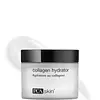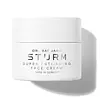What's inside
What's inside
 Key Ingredients
Key Ingredients

 Benefits
Benefits

 Concerns
Concerns

 Ingredients Side-by-side
Ingredients Side-by-side

Water
Skin ConditioningC12-15 Alkyl Benzoate
AntimicrobialGlycerin
HumectantGlyceryl Stearate
EmollientCetearyl Alcohol
EmollientIsopropyl Palmitate
EmollientButyrospermum Parkii Butter
Skin ConditioningCyclopentasiloxane
EmollientDimethicone
EmollientCetyl Alcohol
EmollientPolysorbate 60
EmulsifyingTetrahexyldecyl Ascorbate
AntioxidantAllantoin
Skin ConditioningAloe Barbadensis Leaf Extract
EmollientChamomilla Recutita Flower Extract
MaskingCucumis Sativus Fruit Extract
EmollientEthylhexylglycerin
Skin ConditioningGlycol Distearate
EmollientHelianthus Annuus Seed Oil
EmollientHydrolyzed Wheat Protein
Skin ConditioningOlea Europaea Fruit Oil
MaskingPhenoxyethanol
PreservativePotassium Cetyl Phosphate
EmulsifyingPrunus Amygdalus Dulcis Oil
Skin ConditioningSodium Hyaluronate
HumectantSodium PCA
HumectantTocopherol
AntioxidantXanthan Gum
EmulsifyingCarbomer
Emulsion StabilisingSodium Hydroxide
BufferingTetrasodium EDTA
Water, C12-15 Alkyl Benzoate, Glycerin, Glyceryl Stearate, Cetearyl Alcohol, Isopropyl Palmitate, Butyrospermum Parkii Butter, Cyclopentasiloxane, Dimethicone, Cetyl Alcohol, Polysorbate 60, Tetrahexyldecyl Ascorbate, Allantoin, Aloe Barbadensis Leaf Extract, Chamomilla Recutita Flower Extract, Cucumis Sativus Fruit Extract, Ethylhexylglycerin, Glycol Distearate, Helianthus Annuus Seed Oil, Hydrolyzed Wheat Protein, Olea Europaea Fruit Oil, Phenoxyethanol, Potassium Cetyl Phosphate, Prunus Amygdalus Dulcis Oil, Sodium Hyaluronate, Sodium PCA, Tocopherol, Xanthan Gum, Carbomer, Sodium Hydroxide, Tetrasodium EDTA
Water
Skin ConditioningOctyldodecanol
EmollientUrea
BufferingGlycerin
HumectantButyrospermum Parkii Butter
Skin ConditioningDecyl Oleate
EmollientZea Mays Germ Oil
EmollientC12-15 Alkyl Benzoate
AntimicrobialCetearyl Alcohol
EmollientGlyceryl Stearate
EmollientVitis Vinifera Seed Oil
EmollientLactobacillus/Portulaca Oleracea Ferment Extract
AntioxidantPersea Gratissima Oil
Skin ConditioningSorbitol
HumectantPropanediol
SolventPotassium Cetyl Phosphate
EmulsifyingTocopheryl Acetate
AntioxidantDimethicone
EmollientPhenoxyethanol
PreservativeHydrogenated Palm Glycerides
EmollientPanthenol
Skin ConditioningPhytosterols
Skin ConditioningOlea Europaea Fruit Oil
MaskingCarbomer
Emulsion StabilisingXanthan Gum
EmulsifyingEthylhexylglycerin
Skin ConditioningPotassium Sorbate
PreservativeLeuconostoc/Radish Root Ferment Filtrate
AntimicrobialAlcohol
AntimicrobialSorbitan Oleate
EmulsifyingCaprylic/Capric Triglyceride
MaskingBaicalin
AntioxidantAscorbyl Palmitate
AntioxidantPantolactone
HumectantCitric Acid
BufferingAscorbic Acid
AntioxidantWater, Octyldodecanol, Urea, Glycerin, Butyrospermum Parkii Butter, Decyl Oleate, Zea Mays Germ Oil, C12-15 Alkyl Benzoate, Cetearyl Alcohol, Glyceryl Stearate, Vitis Vinifera Seed Oil, Lactobacillus/Portulaca Oleracea Ferment Extract, Persea Gratissima Oil, Sorbitol, Propanediol, Potassium Cetyl Phosphate, Tocopheryl Acetate, Dimethicone, Phenoxyethanol, Hydrogenated Palm Glycerides, Panthenol, Phytosterols, Olea Europaea Fruit Oil, Carbomer, Xanthan Gum, Ethylhexylglycerin, Potassium Sorbate, Leuconostoc/Radish Root Ferment Filtrate, Alcohol, Sorbitan Oleate, Caprylic/Capric Triglyceride, Baicalin, Ascorbyl Palmitate, Pantolactone, Citric Acid, Ascorbic Acid
 Reviews
Reviews

Ingredients Explained
These ingredients are found in both products.
Ingredients higher up in an ingredient list are typically present in a larger amount.
This ingredient is also known as shea butter. It is an effective skin hydrator and emollient.
Emollients help soothe and soften your skin. It does this by creating a protective film on your skin. This barrier helps trap moisture and keeps your skin hydrated. Emollients may be effective at treating dry or itchy skin.
Shea butter is rich in antioxidants. Antioxidants help fight free-radicals, or molecules that may harm the body. It is also full of fatty acids including stearic acid and linoleic acid. These acids help replenish the skin and keep skin moisturized.
While Shea Butter has an SPF rating of about 3-4, it is not a sunscreen replacement.
Shea butter may not be fungal acne safe. We recommend speaking with a professional if you have any concerns.
Learn more about Butyrospermum Parkii ButterC12-15 Alkyl Benzoate is made up of Benzoic Acid and long chain alcohols. It has a low molecular weight.
C12-15 Alkyl Benzoate is an emollient and texture enhancer. Due to its solubility, it is often used in sunscreens to help evenly distribute active ingredients.
As an emollient, C12-15 Alkyl Benzoate helps soften and hydrate your skin. Emollients create a film on your skin that traps moisture within.
This ingredient has been reported to cause eye irritation.
Learn more about C12-15 Alkyl BenzoateCarbomer is a polymer of acrylic acid. Its main role is to create a gel consistency.
A high amount of carbomer can cause pilling or balling up of products. Don't worry, most products contain 1% or less of carbomer.
Cetearyl alcohol is a mixture of two fatty alcohols: cetyl alcohol and stearyl alcohol. It is mainly used as an emulsifier. Emulsifiers help prevent the separation of oils and products. Due to its composition, it can also be used to thicken a product or help create foam.
Cetearyl alcohol is an emollient. Emollients help soothe and hydrate the skin by trapping moisture.
Studies show Cetearyl alcohol is non-toxic and non-irritating. The FDA allows products labeled "alcohol-free" to have fatty alcohols.
This ingredient is usually derived from plant oils such as palm, vegetable, or coconut oils. There is debate on whether this ingredient will cause acne.
Due to the fatty acid base, this ingredient may not be Malassezia folliculitis safe.
Learn more about Cetearyl AlcoholDimethicone is a type of synthetic silicone created from natural materials such as quartz.
What it does:
Dimethicone comes in different viscosities:
Depending on the viscosity, dimethicone has different properties.
Ingredients lists don't always show which type is used, so we recommend reaching out to the brand if you have questions about the viscosity.
This ingredient is unlikely to cause irritation because it does not get absorbed into skin. However, people with silicone allergies should be careful about using this ingredient.
Note: Dimethicone may contribute to pilling. This is because it is not oil or water soluble, so pilling may occur when layered with products. When mixed with heavy oils in a formula, the outcome is also quite greasy.
Learn more about DimethiconeEthylhexylglycerin (we can't pronounce this either) is commonly used as a preservative and skin softener. It is derived from glyceryl.
You might see Ethylhexylglycerin often paired with other preservatives such as phenoxyethanol. Ethylhexylglycerin has been found to increase the effectiveness of these other preservatives.
Glycerin is already naturally found in your skin. It helps moisturize and protect your skin.
A study from 2016 found glycerin to be more effective as a humectant than AHAs and hyaluronic acid.
As a humectant, it helps the skin stay hydrated by pulling moisture to your skin. The low molecular weight of glycerin allows it to pull moisture into the deeper layers of your skin.
Hydrated skin improves your skin barrier; Your skin barrier helps protect against irritants and bacteria.
Glycerin has also been found to have antimicrobial and antiviral properties. Due to these properties, glycerin is often used in wound and burn treatments.
In cosmetics, glycerin is usually derived from plants such as soybean or palm. However, it can also be sourced from animals, such as tallow or animal fat.
This ingredient is organic, colorless, odorless, and non-toxic.
Glycerin is the name for this ingredient in American English. British English uses Glycerol/Glycerine.
Learn more about GlycerinGlyceryl Stearate is a mix of glycerin and stearic acid.
It is used to stabilize the mixing of water and oil ingredients. By preventing these ingredients from separating, it can help elongate shelf life. It can also help thicken the product's texture.
As an emollient, it helps soften skin and supports barrier-replenishing ingredients.
In cosmetics, Glyceryl Stearate is often made from vegetable oils or synthetically produced.
This ingredient may not be fungal-acne safe
Fun fact: The human body also creates Glyceryl Stearate naturally.
Learn more about Glyceryl StearateOlea Europaea Fruit Oil is the fixed oil obtained from the ripe fruit of the Olive. In other words - olive oil.
The primary contents of olive oil are glycerides of the fatty acids linoleic, oleic and palmitic.
Olive oil also contains antioxidants such as Vitamin E. Antioxidants may help reduce signs of aging by fighting unstable free-radical molecules. It also contains Vitamins A (retinol), D, and K.
The squalene in olive oil makes it a great emollient. Emollients help soothe and soften your skin by trapping moisture in. This makes olive oil a great skin moisturizer.
Studies show olive oil to have antibacterial and antifungal properties in low concentrations. Another study found olive oil irritated sensitive oily skin. We always recommend speaking with a professional about using this ingredient in your routine.
Due to the fatty acid content, this ingredient may not be fungal-acne safe.
Learn more about Olea Europaea Fruit OilPhenoxyethanol is a preservative that has germicide, antimicrobial, and aromatic properties. Studies show that phenoxyethanol can prevent microbial growth. By itself, it has a scent that is similar to that of a rose.
It's often used in formulations along with Caprylyl Glycol to preserve the shelf life of products.
Potassium Cetyl Phosphate is the potassium salt of a mixture. This mixture consists of the esters from phosphoricacid and cetyl alcohol.
Potassium Cetyl Phosphate is an emulsifier and cleansing agent. Emulsifiers help stabilize a product. It does this by preventing certain ingredients from separating.
As a cleansing agent, Potassium Cetyl Phosphate helps gather oils, dirts, and pollutants from your skin. This makes it easier to rinse them away with water.
Learn more about Potassium Cetyl PhosphateWater. It's the most common cosmetic ingredient of all. You'll usually see it at the top of ingredient lists, meaning that it makes up the largest part of the product.
So why is it so popular? Water most often acts as a solvent - this means that it helps dissolve other ingredients into the formulation.
You'll also recognize water as that liquid we all need to stay alive. If you see this, drink a glass of water. Stay hydrated!
Learn more about WaterXanthan gum is used as a stabilizer and thickener within cosmetic products. It helps give products a sticky, thick feeling - preventing them from being too runny.
On the technical side of things, xanthan gum is a polysaccharide - a combination consisting of multiple sugar molecules bonded together.
Xanthan gum is a pretty common and great ingredient. It is a natural, non-toxic, non-irritating ingredient that is also commonly used in food products.
Learn more about Xanthan Gum